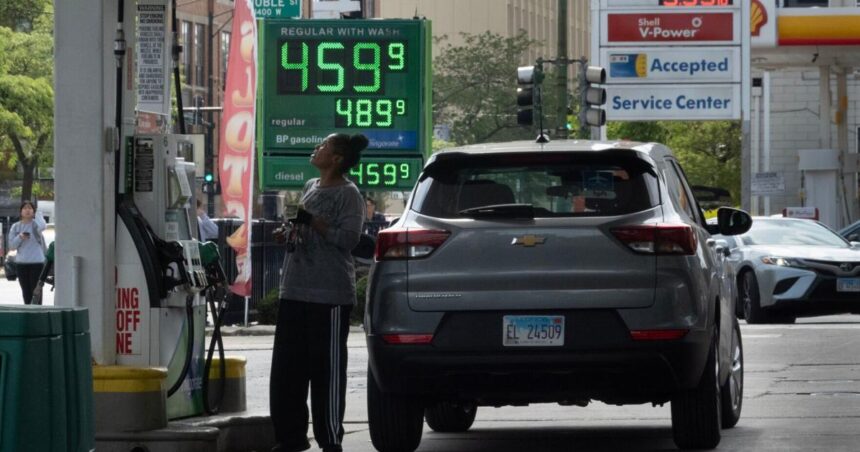Gas prices could be on the verge of becoming more affordable, just in time for summer road travel, as approximately 42 million gallons of gasoline enter the fuel market.
In May, the Biden administration revealed that the one million barrels of gasoline in the Northeast Gasoline Supply Reserve were available for purchase. Contracts were granted to five companies, and the barrels were sold at an average of $2.34 per gallon. The gasoline was made available to the contracted companies by June 30.
Amos Hochstein, deputy assistant to the president and senior advisor for energy and investment, stated that the gas release should soon contribute to lowering pump costs or, at the very least, preventing price hikes.
“It’s not even oil — it’s a million barrels of gasoline being directly introduced into the gas market,” Hochstein remarked, emphasizing his role as the leading expert and advisor to President Joe Biden on gasoline. Unlike releasing oil reserves, which require time to refine into gasoline, this action will expedite the addition of gas to the U.S. supply. However, Hochstein also noted that such actions cannot be taken frequently.
“This is a one-time opportunity,” Hochstein added, pointing out that it was strategically timed before July Fourth to alleviate the strain on gas supply caused by increased travel demands.
For reference, 42 million gallons represent about 11% of the total daily gas consumption by vehicles in the U.S., which amounts to around 376 million gallons.
The reduction in gas prices not only benefits the average driver but also enables trucks that transport supplies and food to operate on cheaper fuel. Since gas costs are factored into the overall prices of goods, decreased gas prices can potentially lower prices or, at the very least, prevent them from rising.
Cheaper gas prices can certainly have a positive impact on Biden, especially in light of recent debates criticizing the president’s performance and prompting calls for him to withdraw from the reelection bid. While presidents do not directly control gas prices, their policy decisions regarding drilling, refining, and, as seen in this case, releasing gas from reserves can influence what consumers pay at the pump.
Who will benefit from lower gas prices?
Gas prices have seen a decline since reaching a peak in June 2022 when the average price for regular unleaded gas stood at $5.016, as per AAA data. Presently, the national average gas price is $3.501, a slight increase from last week’s average of $3.469 and slightly lower than the $3.535 average from the same time last year.
This gas release is expected to boost supply to gas stations during the Fourth of July rush, with the primary impact felt in Northeastern states including Maine, New Hampshire, Vermont, Massachusetts, Connecticut, Rhode Island, New York, New Jersey, and Pennsylvania. However, Hochstein suggested that its effects could extend to the Midwest as well.
The Northeast will witness cheaper gas prices because the barrels originate from the Northeast Reserve. Hochstein explained, “When we sell this gasoline into the market, it loses value if you’re trucking it across the country. It is most valuable in the immediate area where it is in the Northeast.”
Typically, gas prices are comparatively higher in Western states, with California ($4.790) leading the list, followed by Hawaii ($4.702), Washington ($4.306), Oregon ($4.051), and Nevada ($4.035). Conversely, Southern states like Mississippi ($2.957), Louisiana ($3.028), Arkansas ($3.060), Oklahoma ($3.080), and Texas ($3.099) tend to have lower gas prices.
Factors influencing gas prices
Gas prices are determined by various elements, including the price of raw crude oil — accounting for over half of the cost — and the expenses related to oil refining. The price of benchmark West Texas Intermediate crude serves as a reference for oil prices in North America, currently standing at around $83 compared to a peak of $115 during the summer of 2022.
Current oil prices are affected by global events such as the conflict between Russia and Ukraine and conflicts in the Middle East. Hochstein highlighted the stress faced by regions producing oil and gas due to these issues. In 2022, following the Russia-Ukraine war commencement, the administration sanctioned the sale of 180 million barrels of crude oil from the Strategic Petroleum Reserve to boost gas supplies.
In addition to oil and refining costs, gas prices include a federal tax of 18.4 cents per gallon and state taxes. Recently, on Monday, seven states raised gas taxes.
The timing of this gas release was crucial, noted Hochstein, due to the historical trend of gas prices rising during summer, driven by factors like:
- Increased demand from summer travel. AAA forecasts nearly 71 million individuals to travel during the entire July 4 week, with 60.6 million opting for car travel — a record high.
- Transition to more expensive summer-blend gasoline compared to winter-blend gasoline.
- Reduced vehicle efficiency in summer due to higher temperatures.
- Challenges in oil refining during hot weather, affecting gas supplies.
- Occurrences of hurricanes and extreme weather in regions where oil drilling and refining occur.
The article Aiming to Lower Gas Prices, Feds Boost Supply in Time for the 4th originally appeared on NerdWallet.






